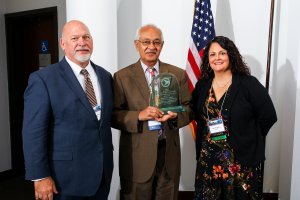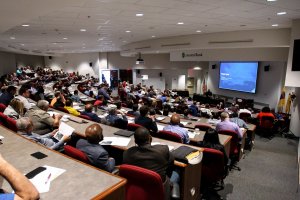Announced every year at the NJDOT Research Showcase, this award honors someone who worked with the Department on a research project that has been implemented to solve a relevant problem. This year, a Rutgers and CAIT-affiliated faculty member took home the award for his innovative work on the development of a new protocol for accepting new coating systems.

(Left to Right) NJDOT Assistant Commissioner Michael Russo presents Dr. Balaguru with the 2019 NJDOT Research Implementation Award, alongside NJDOT Bureau of Research Manager Amanda Gendek. Photo ©Larry Levanti Photography.
The 21st Annual New Jersey Department of Transportation (NJDOT) Research Showcase this October served as an opportunity for the statewide transportation community to learn about different, innovative academic research underway and to share technology transfer activities.
As part of the event, various awards were presented for field implementable research, innovation, and outstanding work by university students studying in a transportation-related field, including the 2019 NJDOT Research Implementation Award. This was won by Dr. Perumalsamy N. Balaguru, a Distinguished Professor in the Department of Civil and Environmental Engineering at Rutgers School of Engineering (SoE) and a Center for Advanced Infrastructure and Transportation (CAIT) affiliated researcher.
Dr. Balaguru won the award for his work with NJDOT on developing a new protocol for accepting paint systems for over-coating steel surfaces.
“An efficient and economical acceptance protocol is needed to encourage innovation of coating systems,” he said. “I am glad that our efforts to advance the state of the art in accelerated testing for reducing the time and resources needed for approval of new coatings is being recognized. This recognition and the nationwide selection as one of the “Sweet 16 Research Projects” will be of great help for fast implementation of this research by not only NJDOT, but also by other states.”
The NJDOT Bureau of Materials initiated the research project to help improve the NJDOT program for accepting over-coating paint systems, and researchers were tasked with identifying a test method and road map for accomplishing this. Other collaborators on the project included co-PI Dr. Husam Najm, a professor at the Rutgers Department of Civil and Environmental Engineering, and NJDOT Bureau of Research project manager Dr. Giri Venkiteela.
After a literature review, the research team concluded that current test methods are time consuming and expensive to run, resulting in limited requests for adding new coating systems. The current prolonged and expensive qualifying tests also discouraged innovation from new companies and existing vendors.
The research team was challenged to develop a new, efficient test method. A protocol that requires testing for only 100 days was developed. The corrosion creep rate was also enhanced by adding a deep freeze cycle.
Some other notable differences include that the current testing takes two years to complete, while the method developed by Dr. Balaguru reduces the timeframe to six months. The test chamber also is very economical to build, costing approximately $30,000 compared to quotes that have gone as high as $250,000.
Instead of monitoring two samples and taking measurements, the new method also measures strength at three different locations at least nine times, which provides a good and statistically reliable response-variable indicator. The response variable is based on direct adhesion strength of the coating at various stages of corrosion. These “pull-off” strengths provide significantly decreasing and repeatable measurements for quantifying degradation of the prime-coat.
“Overcoating” is a common term used to describe bridge maintenance painting where existing paint is only partially removed and a new coat is applied over the leftover paint, bare steel, and rusted surfaces.

David C. Woessner, Executive VP – Corporate Development and Regulatory Affairs, LM Industries + Local Motors, gave the keynote speech on connected vehicles at the 2019 NJDOT Research Showcase. Photo ©Larry Levanti Photography.
This practice is similar to traditional maintenance and touch-up painting methods, but, overcoating differs in several ways.
Traditionally, maintenance painting was either done as part of routine life-cycle maintenance for larger bridges or in conjunction with other maintenance activities, such as steel component replacement. Overcoating is now viewed as an alternative to fully removing and replacing existing paint that is no longer offering adequate protection.
Due to ever-tightening budgets, some bridge owners even use it as a primary bridge-rehabilitation option and a reasonable substitute for abrasive blasting and complete repainting. In the past, maintenance painting has generally used coatings similar to the existing coating, for example, using a lead-containing alkyd over an existing lead-containing alkyd. Now, overcoating may involve materials that are vastly different from the original coating.
In the end, NJDOT found that the research team did develop an efficient test method incorporating key parameters of the current ASTM and American Association of State Highway and Transportation Officials (AASHTO) test methods. The results were presented at Transportation Research Board (TRB) meeting in January 2018. Also, earlier this year, The Research Advisory Committee of AASHTO selected this NJDOT project as one of the winners in the 2019 AASHTO Sweet 16 Competition.

